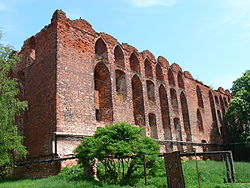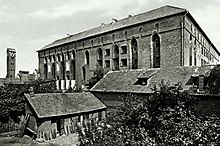Neman, Russia
This articleneeds additional citations forverification.(August 2011) |
Neman
Неман | |
|---|---|
 Castle ruins | |
| Coordinates:55°02′N22°02′E/ 55.033°N 22.033°E | |
| Country | Russia |
| Federal subject | Kaliningrad Oblast[1] |
| Administrative district | Nemansky District[1] |
| Town of district significance | Neman[1] |
| Founded | 1288[2] |
| Town status since | 1722 |
| Elevation | 20 m (70 ft) |
| Population | |
| • Total | 11,798 |
| •Capitalof | Nemansky District,[1]town of district significance of Neman[1] |
| •Municipal district | Nemansky Municipal District[4] |
| •Urban settlement | Nemanskoye Urban Settlement[4] |
| •Capitalof | Nemansky Municipal District,[4]Nemanskoye Urban Settlement[4] |
| Time zone | UTC+2(MSK–1 |
| Postal code(s)[6] | 238710, 238711 |
| Dialing code(s) | +7 40162 |
| OKTMOID | 27514000001 |
| Website | neman |
Neman(Russian:Не́ман;German:Ragnit;Lithuanian:Ragainė), is atownand theadministrative centerofNemansky DistrictinKaliningrad Oblast,Russia,located in the historic region ofLithuania Minor,on the steep southern bank of theNeman River,where it forms the Russian border with theKlaipėda RegioninLithuania,and 130 kilometers (81 mi) northeast ofKaliningrad,the administrative center of theoblast.Population figures:11,798 (2010 Russian census);[3]12,714 (2002 Census);[7]13,821 (1989 Soviet census).[8]
History
[edit]
Ragnita(fromOld Prussian:ragas,"spur"), founded in 1288,[2]was a settlement of theBaltic(Old Prussian) tribe ofSkalvians.It was contested by theGrand Duchy of Lithuaniasince its creation in the 13th century, and on April 23, 1289 it was conquered by theTeutonic Knights,who built a castle there between 1397 and 1409, which later became the seat of aKomtur.Construction works were supervised by the Master of the Teutonic Order Konrad Fellenstein of Marienburg.[9]A few decades later, a now-destroyed 25 meter guard tower was built onto the castle. The stronghold was calledLandeshut,but the name did not become popular and the name Ragnit, after a local river, atributaryof the Memel (outside of Prussia calledNeman), continued to be used.
Although the settlement had an important castle not only guarding the Prussian lands of theState of the Teutonic Orderfrom the north but also serving as a military base for the Knights' campaigns into adjacentSamogitia,it was living in the shadow of the nearby city of Tilsit (present-daySovetsk). After the dissolution of the Order's State under its last Grand MasterAlbrecht von Hohenzollern,Ragnit on April 10, 1525 became a part of theDuchy of Prussia,which was ruled by theHouse of Hohenzollernas a fief of theKingdom of Polanduntil 1657. The duchy was inherited by the Hohenzollern margraves ofBrandenburgin 1618, becoming an integral part ofBrandenburg-Prussia,whereby remote Ragnit retained its status as a regional capital.

Ragnit was devastated by Tatars during theSecond Northern Warin 1656 and again bySwedishforces during theScanian Warin 1678, while the "Great Elector"Frederick William of Brandenburghad achieved full sovereignty over Ducal Prussia by the 1657Treaty of Wehlau.His son and successor ElectorFrederick IIIelevated himself to aKinginPrussiain 1701. He granted Ragnittown privilegeson April 6, 1722. It was again destroyed during theSeven Years' War,this time byRussianforces in 1757.
Incorporated into theProvince of East Prussiafrom 1815, Ragnit became a part of theGerman Empireupon the Prussian-ledunification of Germanyin 1871. Its castle, having long lost its defensive purpose, became a court and prison. On November 1, 1892, a railroad line linking the town with Tilsit (now Sovetsk) was opened. It was built to develop the wood industry in the area, but the development did not actually start and the area's economy remained dominated by food production. When Germany had to cede theKlaipėda Regionnorth of the Neman River to theConference of Ambassadorsaccording to the 1919Treaty of Versailles,Ragnit became a border town. In 1922, it lost its status as an administrative capital in favor of Tilsit. It was the location of a Nazi prison underNazi Germany.[10]
DuringWorld War II,on January 19, 1945, Ragnit was captured without a fight by the3rd Belorussian Frontof theRed Armyin the course of theEast Prussian Offensive.Much of the town was destroyed, including the castle, which remains ruined. In accordance to the 1945Potsdam Agreement,the town became a part ofKaliningrad Oblastof theRussian SFSR.It was renamed to Neman in 1946.[2]Most of the local inhabitants who had not fled during the Soviet conquest ofEast Prussiawere subsequentlyexpelledto Germany in accordance with the Potsdam Agreement.
Administrative and municipal status
[edit]Within theframework of administrative divisions,Neman serves as theadministrative centerofNemansky District.[1]As an administrative division, it is, together with nineteenrural localities,incorporated within Nemansky District as thetown of district significanceof Neman.[1]As amunicipal division,the town of district significance of Neman is incorporated within Nemansky Municipal District asNemanskoye Urban Settlement.[4]
Lithuanian community
[edit]Located in the historic region ofLithuania Minor,for centuries Ragnit was an important center ofLithuanian culture.From 1549 to 1563, famous Lithuanian writer and translator (who wrote the first book in the Lithuanian language, "Catechismusa Prasty Szadei" ( "The Simple Words of Catechism" ))Martynas Mažvydaswas priest and Archdiacon of Ragainė. While living in Ragainė he wrote "The Song of St. Ambrosy" (with a dedication in Lithuanian), translated "The Form of Baptism" from German into Lithuanian, published "The Prussian Agenda" into the prayer "Paraphrasis". One of his major works was "The Christian Songs" (Giesmės Krikščioniškos). In the 19th century, after theJanuary Uprisingwhen theLithuanian languagewas banned from the office in all ofRussian-ruled Lithuania, books in that language were printed in Ragnit and then smuggled to Russia by theLithuanian book smugglers(knygnešiai). The first issue of the Lithuanian newspaperAuszrawas published in the town in 1883. According to German data 17,500Lithuanianslived in the Ragnit district in 1890 (32% of the population).[11]In 2010Lithuanianscomposed 2.8% of the town population, being the third largest ethnic group afterRussiansandBelarusians.
Notable people
[edit]- Martynas Mažvydas(1510–1563), Lithuanian priest, writer, translator
- Johann Friedrich Domhardt(1712-1781), Administrator, Agriculturalist
- Johann Friedrich Reiffenstein(1719–1793), German painter, antiquarian
- Julius Bacher(1810–1889), German novelist
- Martynas Jankus(1858-1946), Lithuanian printer, publicist
- Erich Klossowski(1875-1949), German-Polish art historian, painter
- Walter Bruno Henning(1908–1967), German scholar
International relations
[edit]
Twin towns and sister cities
[edit]Neman istwinnedwith:
References
[edit]Notes
[edit]- ^abcdefghResolution #640
- ^abcЭнциклопедия Города России.Moscow: Большая Российская Энциклопедия. 2003. p. 294.ISBN5-7107-7399-9.
- ^abRussian Federal State Statistics Service (2011).Всероссийская перепись населения 2010 года. Том 1[2010 All-Russian Population Census, vol. 1].Всероссийская перепись населения 2010 года [2010 All-Russia Population Census](in Russian).Federal State Statistics Service.
- ^abcdeLaw #257
- ^"Об исчислении времени".Официальный интернет-портал правовой информации(in Russian). June 3, 2011.RetrievedJanuary 19,2019.
- ^Почта России. Информационно-вычислительный центр ОАСУ РПО. (Russian Post).Поиск объектов почтовой связи(Postal Objects Search)(in Russian)
- ^Federal State Statistics Service(May 21, 2004).Численность населения России, субъектов Российской Федерации в составе федеральных округов, районов, городских поселений, сельских населённых пунктов – районных центров и сельских населённых пунктов с населением 3 тысячи и более человек[Population of Russia, Its Federal Districts, Federal Subjects, Districts, Urban Localities, Rural Localities—Administrative Centers, and Rural Localities with Population of Over 3,000](XLS).Всероссийская перепись населения 2002 года [All-Russia Population Census of 2002](in Russian).
- ^Всесоюзная перепись населения 1989 г. Численность наличного населения союзных и автономных республик, автономных областей и округов, краёв, областей, районов, городских поселений и сёл-райцентров[All Union Population Census of 1989: Present Population of Union and Autonomous Republics, Autonomous Oblasts and Okrugs, Krais, Oblasts, Districts, Urban Settlements, and Villages Serving as District Administrative Centers].Всесоюзная перепись населения 1989 года [All-Union Population Census of 1989](in Russian). Институт демографии Национального исследовательского университета: Высшая школа экономики [Institute of Demography at the National Research University: Higher School of Economics]. 1989 – viaDemoscope Weekly.
- ^"Ragnit castle".autc.lt.RetrievedMarch 6,2021.
- ^"Zuchthaus Ragnit".Bundesarchiv.de(in German).RetrievedMay 7,2022.
- ^"Deutsche Verwaltungsgeschichte Ostpreußen, Kreis Tilsit-Ragnit".Archived fromthe originalon January 12, 2007.
Sources
[edit]- Правительство Калининградской области. Постановление №640 от 30 августа 2011 г. «Об утверждении реестра объектов административно-территориального деления Калининградской области», в ред. Постановления №877 от 21 ноября 2011 г «О внесении изменения в Постановление Правительства Калининградской области от 30 августа 2011 г. №640». Вступил в силу со дня официального опубликования. Опубликован: "Калининградская правда" (вкладыш "Официально" ), №170, 15 сентября 2011 г.(Government of Kaliningrad Oblast. Resolution #640 of August 30, 2011On the Adoption of the Registry of the Objects of the Administrative-Territorial Divisions of Kaliningrad Oblast,as amended by the Resolution #877 of November 21, 2011On Amending the Resolution of the Government of Kaliningrad Oblast #640 of August 30, 2011.Effective as of the day of the official publication.).
- Калининградская областная Дума. Закон №257 от 30 июня 2008 г. «Об организации местного самоуправления на территории муниципального образования "Неманский городской округ" », в ред. Закона №89 от 15 февраля 2012 г «О внесении изменений в Закон Калининградской области "Об организации местного самоуправления на территории муниципального образования" Неманский городской округ "». Вступил в силу со дня официального опубликования. Опубликован:" Калининградская правда ", №124, 11 июля 2008 г.(Kaliningrad Oblast Duma. Law #257 of June 30, 2008On the Organization of the Local Self-Government on the Territory of the Municipal Formation of "Nemansky Urban Okrug",as amended by the Law #89 of February 15, 2012On Amending the Law of Kaliningrad Oblast "On the Organization of the Local Self-Government on the Territory of the Municipal Formation of" Nemansky Urban Okrug ".Effective as of the day of the official publication.).





